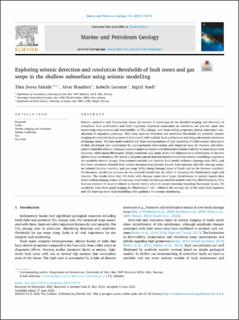| dc.contributor.author | Faleide, Thea Sveva | |
| dc.contributor.author | Braathen, Alvar | |
| dc.contributor.author | Lecomte, Isabelle Christine | |
| dc.contributor.author | Anell, Ingrid | |
| dc.date.accessioned | 2022-11-30T10:31:25Z | |
| dc.date.available | 2022-11-30T10:31:25Z | |
| dc.date.created | 2022-09-26T12:51:50Z | |
| dc.date.issued | 2022 | |
| dc.identifier.issn | 0264-8172 | |
| dc.identifier.uri | https://hdl.handle.net/11250/3034991 | |
| dc.description.abstract | Seismic resolution and illumination issues are sources of challenges in the detailed imaging and detection of subsurface fault architecture and fluid migration. Improved constraints on resolution can provide input into monitoring requirements and detectability of CO2 leakage, and fault-sealing properties during subsurface visualization of migration pathways. This study explores detection and resolution thresholds via synthetic seismic imaging of a detailed shallow normal fault model with realistic fault architecture including sub-seismic structures of damage zones. The base fault model is built from interpretations of high-resolution P-Cable seismic data and is further developed and conditioned by outcrop-based observations and empirical laws for fracture and deformation band distribution. Damage zones of sandstone layers host deformation bands contrary to shale layers with fractures, while mixed lithologies (shaley sandstone and sandy shale) are subjected to a combination of the two deformation mechanisms. We utilize a 2D point-spread function based convolution seismic modelling to produce the synthetic seismic images. Test scenarios include one baseline fault model without a damage zone (M1), and five more advanced/detailed fault models incorporating features known from outcrops (M2-M6; damage zones, an isolated fracture corridor, and gas seeps (CO2) along damage zones of faults and in the fracture corridor). Furthermore, sensitivity analyses on two selected models test the effect of changing the illumination angle and wavelet. The results show that: (1) faults with damage zones have larger disturbances in seismic signals than faults without damage zones, (2) stronger amplitudes are distinguished for models with CO2-filled fractures, (3) a fracture corridor (5 m at it widest) is clearly visible where it crosses horizons bounding horizontal layers, (4) sensitivity tests show good imaging for illumination ≥45°, which is the average dip of the main fault segment, and (5) learnings from fault modelling offer guidance for seismic monitoring. | en_US |
| dc.language.iso | eng | en_US |
| dc.publisher | Elsevier | en_US |
| dc.rights | Navngivelse 4.0 Internasjonal | * |
| dc.rights.uri | http://creativecommons.org/licenses/by/4.0/deed.no | * |
| dc.title | Exploring seismic detection and resolution thresholds of fault zones and gas seeps in the shallow subsurface using seismic modelling | en_US |
| dc.type | Journal article | en_US |
| dc.type | Peer reviewed | en_US |
| dc.description.version | publishedVersion | en_US |
| dc.rights.holder | Copyright 2022 the authors | en_US |
| dc.source.articlenumber | 105776 | en_US |
| cristin.ispublished | true | |
| cristin.fulltext | original | |
| cristin.qualitycode | 1 | |
| dc.identifier.doi | 10.1016/j.marpetgeo.2022.105776 | |
| dc.identifier.cristin | 2055440 | |
| dc.source.journal | Marine and Petroleum Geology | en_US |
| dc.identifier.citation | Marine and Petroleum Geology. 2022, 143, 105776. | en_US |
| dc.source.volume | 143 | en_US |

